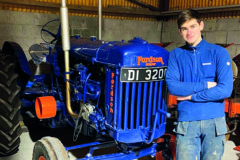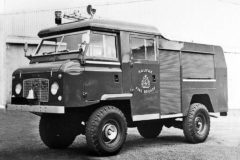The wartime Willys Jeep
Posted by Chris Graham on 26th April 2021
Nowadays, 4×4 vehicles are commonplace on most farms but, as Jo Roberts explains, it was the wartime Willys Jeep that blazed the trail.

The wartime Willys Jeep: Pete was inspired to buy a Jeep because our father had owned one as a working farm vehicle in the 1950s.
Now the Second World War is a safe distance behind us, some of us have begun to see this period in history in a romantic light. Rather than focussing on the genuine horrors of war, we peer back through rose-tinted spectacles at the way people pulled together during this time, and how hardship brought out our strengths and united us.
Useful mechanisation
We see the old vehicles of the war in a romantic light, too, and have a soft spot for any tractor or truck that served us through our darkest hours. A vehicle which did that for its country during wartime, has now achieved the status of a veteran. But this doesn’t just apply to military vehicles; those tractors that tilled the land and helped feed us during those lean times also deserve our appreciation as well.
It’s no wonder then that we Brits have a fondness for the Fordson Model N. By the time war began, this little workhorse was the most popular tractor in Britain, and it’s generally thought of as the tractor that kept Britain farming during those dark days.

Pete bought this Jeep about 30 years ago, from a roadie for the British rock band, Jethro Tull.
Of course, larger, lowland farms had been using tractors long before the war started but, for many small-scale farmers, the Fordson Model N was their first foray into the world of mechanisation. For my family, living in the mountains of North Wales, mechanisation didn’t come about until my grandfather was persuaded to buy a secondhand Fordson Model N in the 1950s and, during wartime, farming had continued with the help of horses, in the time-honoured way.
Late-adopters
It wasn’t until well after the war that my family began buying machinery and, even then, it was a well-used Fordson N that my grandfather never took to. Most hill farmers were the same, they simply couldn’t afford to invest in new machinery and preferred to stick to their tried and tested methods.
During the 1940s, there were vast tracts of rough land, hills and moorland, in particular, which couldn’t be accessed by a farm vehicle at all. With the Land Rover and the quad bike yet to be invented, and the dainty, two-wheel-drive tractors of the period inadequate for use on steep slopes, there was no other way for the farmers of yesteryear to get to the far-flung reaches of their farms, except on foot or horseback.

With its nippy, 60hp, ‘Go Devil’ engine, the Jeep has provided a lot of fun over the years.
The tough old sheep farmers of the past had to walk many miles during their working days and, when the ex-US Military Jeep arrived on the scene, it must have felt like a godsend. A rather incongruous sight in the Welsh hills, these now iconic vehicles proved to be well suited to the terrain, and far better at traversing rough ground than the farm tractors of the period.
Multi-purpose vehicle
A sadly now deceased neighbour of mine, Aneurin Hughes, recalled that, in the 1950s, his family owned both a Ferguson tractor and a Willys Jeep. While the Ferguson tractor was lethal to drive on most of their steeply-sloping land, the Jeep would go just about anywhere, and so got used for almost every job; it also doubled-up as the family car.
My family invested in an old Willys Jeep in the early 1950s, and it, too, was used as the family car. However, what it was best at was accessing the steep reaches of the farmland in this part of the Snowdonia National Park, which my father would often travel to when working, gathering sheep for routine treatment like shearing. The Jeep was light enough to tread carefully over wet land, and the low gears allowed it to purr up and over terrain where tractors would have been unstable and dangerous.

Jeeps could go to places where regular tractors of the day would fear to tread!
Additional benefits
What’s more, a Jeep fitted with a canvas hood offered more protection from the elements than a tractor. Like today’s ‘Mule’, these machines were fast and easy to jump in and out of, making them perfect for checking mountain flocks of sheep, and for carrying feed or fencing supplies to upland areas. Driving one of these nippy machines for the first time must have been a revelation, and it was a game-changer for hill farmers and estate workers. For the first time, it was possible to drive over hill and heath, carrying your tools with you, to places that had previously only been accessible on foot.
The Jeep heavily influenced Maurice Wilks when he designed the first Land Rover, in 1947, and he hoped it could do all that the Jeep had done and more. Land Rovers were expensive new machines though, and many farmers continued to use Jeeps as their farm vehicles through the 1950s and beyond, until secondhand Land Rovers become available at an affordable price.

North Wales after a snowfall has to be one of the best playgrounds ever for a Jeep.
A nod to the past
There are still people out there who have a Jeep for old time’s sake; not to remind themselves of the military, but as a nod to a time when their father or grandfather owned one of these as their main farm vehicle. My brother, Pete, is one of those. It would have been nice if he’d inherited our dad’s old Jeep but, sadly, that was sold in well-worn condition long before Pete was old enough to drive.
Instead, he bought his Jeep about 30 years ago and, interestingly, the seller was a roadie for the rock band Jethro Tull. I wonder if Pete’s fascination with Jeeps comes from the fact that the first vehicle he ever rode in was a Jeep. When he was born, the Jeep was my father’s only mode of transport, so when mum had to be picked up from hospital with the new-born Pete, the Jeep was the vehicle used to drive them home.

Maurice Wilks owned a farm in Anglesey, and his Land Rover design was heavily influenced by the ex-army Jeep he used on the farm.
Pete’s Jeep differs slightly from our father’s old one; it’s a Ford-built example, while dad’s was a Willys Jeep. However, a Ford-built model fits in perfectly with Pete’s other passion, which is Fordson Model N tractors.
Deep-seated fascination
As I mentioned earlier, mechanisation came late to the foothills of Snowdonia, and the Fordson was already an old tractor by the time my father persuaded our grandfather to buy their first example. The old Fordson eventually ended up redundant and was sadly scrapped but, if Pete had been older, I’m sure he would have persuaded dad to let him keep it.

The Jeep is a manoeuvrable little machine, the low sides mean you can get in and out quickly, and the visibility is second to none.
Pete was always fascinated with the primitive-looking Model N, and he bought his first one as soon as he was able. He’s bought a few more over the years since, and now his son, Mathew, has inherited the same fondness for this wartime legend, and is an owner, too.
One of Pete’s favourite Model Ns is his green, 1940 example, fitted with wide wings. Soon after this tractor was made, Fordson wings were redesigned into narrower versions, in a bid to save steel to aid the war effort.

During the 1950s, our father owned this Willys Jeep, which he used for farm work, and also as the family car.
Ploughing ahead
Although our father ploughed with his Fordson, during its working life on the family farm, he never competed in a ploughing match. Dad would probably have thought it was bad enough having to plough all week, without having to go off and do more of it ‘for fun’ at the weekend! I think he’d rather have gone for a drive on his motorbike any day. But, when Pete learned to plough with his Fordson and trailer plough, he decided to compete, and has had some success in local matches.
I’ve always thought of Pete as something of an adrenaline junkie, so it surprised me when he began ploughing with a little, old tractor and archaic trailed plough. But, for Pete, ploughing proved to be quite a meditative thing, and he found it immensely rewarding. And if the Fordson proves a little too slow anytime, he can always take his Jeep off-roading for a different kind of therapy!

Pete, inspired by the Fordson our father used to drive, couldn’t wait to get a Model N of his own.
Willys Jeep
The Willys MB and the Ford GPW are essentially the same vehicle; correctly named the US Army ¼ton 4×4 Command Reconnaissance Truck. ‘Jeeps’, as they became commonly known, were built to a standardised design in huge numbers for the US military and the allied forces, between 1941 and 1945. The ¼ton truck became the world’s first, mass-produced 4WD vehicle, and Eisenhower described it as one of the most decisive weapons to help the US through the war.
The US Military was keen to have a ¼ton reconnaissance vehicle in time for its entry into the war. This vehicle had to follow exact specifications, and automobile manufacturers were invited to submit designs. Three companies did so; Willys Overland, American Bantam, and Ford.

This 1940 Model N sports the wider wings, which were soon discontinued to save on precious materials during the war.
After much research, the Willys vehicle was chosen; most likely it was the powerful, 60hp ‘Go Devil’ engine that swayed the decision. It was crucial that the vehicle was standardised and, therefore, the work of one company. But it was also realised that Willys Overland couldn’t be expected to meet the meet the production demand on its own, so Ford was called in to build the vehicle as well, using Willys’ specifications and engine. Bantam went on to produce Jeep trailers.
During the war, Willys produced 363,000 MB Jeeps, and Ford produced 280,000 GPW Jeeps. Although the Willys Jeeps and the Ford GPW Jeeps are the same vehicle, there are small differences. For instance, the Ford chassis featured an inverted, U-shaped front cross-member, while the Willys version had a cross-member built from a tubular bar. The letter ‘F’ – written in script – can also be seen stamped on many of the Ford parts. In 1944, a composite body, fabricated by American Central, was used by both Ford and Willys.

Pete began collecting Fordson tractors. His son, Mathew, also became a fan – now they have amassed a nice collection.
Many conversions
The Jeep was also heavily adapted. There were amphibious versions, armoured versions, tracked versions and conversions kits to allow Jeeps to be used in extremely cold climates. Jeeps could even be adapted to travel on railway lines, but the most extreme version was the flying Jeep – the Hafner Rotabuggy – which utilised a rotor assembly plus a tail to act as a stabiliser.
Britain, Canada, India, China and Russia were all supplied with US Willys Jeeps, with many being provided under the American Lend-Lease Scheme. The vehicle soon became well-loved, proving to be versatile, dependable, manoeuvrable and almost indestructible. It ended up being used for far more applications than were ever imagined possible and, in many cases, it willingly carried far more weight than it was ever designed to do.
Significantly-repurposed
For those soldiers who were used to driving cars or trucks, the Jeep must have seemed extremely nimble, and many ex-soldiers have fond memories of driving these powerful, lightweight, nippy machines. Sitting in the rear of a Willys Jeep for any length of time couldn’t have been comfortable, though, but driving the vehicle is immense fun. We must remember that Enzo Ferrari famously described the Jeep as ‘America’s only real sports car!’

Our parents on their narrow-wing Fordson in the 1950s.
Willys soon began marketing its 4WD vehicles for civilian use, but the Jeep didn’t need to be marketed for farm use. Anyone who drove one could see how useful it would be on the farm. Even before the war ended, the Jeep had found another purpose well away from the military, in agriculture. In 1944, Life Magazine featured a mayor from Kansas who’d bought a Ford GP Jeep, and was using it with great success on his 2,000-acre farm. In no time at all, increasing numbers of farmers, forestry and estate workers began buying ex-military Jeeps, and so it was that the first farm 4×4, all-terrain vehicle was born, with an unrivalled ability to take its occupants to places where no vehicle had gone before.
For a money-saving subscription to Tractor & Farming Heritage magazine, simply click here





